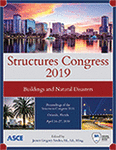Structures Congress 2019
Merging State-of-the-Art Research with Modern Practices to Improve the Quality of Wood Structures Exposed to Decay Fungi
Publication: Structures Congress 2019: Buildings and Natural Disasters
ABSTRACT
The precision of wood construction and quality of wood structures are perceived as being lower than those of steel, and reinforced concrete, and masonry structures. These latter materials have well-established, detailed standards of practice, where the existing standards for wood are mostly product-specific and aimed at manufacturing tolerances and methods. Forensic studies conducted on wood structures substantiates this perception, more often pointing to poor construction execution or material specification in lieu of a flawed design. This paper examines the role of damage mechanisms caused by decay fungi. The state of the art in research regarding non-destructive detection and wood preservation is briefly reviewed, followed by a review of the state of current practices regarding the biodeterioration of structural wood by decay fungi, including initial deterioration identification, determination of decay severity, and damage mitigation measures. A case study of multiple residential condominium buildings is included to highlight these processes. Leveraging findings from research, practice, and the case studies, preliminary recommendations are offered for adoption into a standard of practice for wood structures for design, construction, and service.
Get full access to this article
View all available purchase options and get full access to this chapter.
ACKNOWLEDGMENTS
This work was performed as part of a Special Project sponsored by the American Society of Civil Engineers (ASCE) Structural Engineering Institute (SEI) Technical Activities Division (TAD) awarded to the Committee on the Performance of Wood Structures to establish standards of practice for wood structures. The views expressed are those of the author(s), and may not represent the official position of ASCE or SEI.
RERFERENCES
American Society for Testing and Materials (ASTM). (2017). “Standard guide for evaluating water leakage in building walls.” E2128-17, West Conshohocken, PA.
American Wood Council. (2018). “National design specifications for wood construction.” Leesburg, VA.
ASCE International. (1999). Guideline for structural condition assessment of existing buildings,ASCE/SEI 11-99, Reston, VA.
ASCE International. (2000). Guideline for condition assessment of the building envelope, ASCE 30, Reston, VA.
Dackermann, U., Crews, K., Kasal, B., Li, J., Riggio, M., Rinn, F., and Tannert, T. (2014). “In situ assessment of structural timber using stress-wave measurements.” Mater. Struct., 47(5), 787-803.
De Vetter, L. Stevens, M., and Van Acker, J. (2009). “Fungal decay resistance and durability of organosilicon-treated wood.” Int. Biodeterior. Biodegrad., 63(2), 130-134.
Forest Products Laboratory (FPL). (2000). “Stress wave timing nondestructive evaluation tools for inspecting historic structures; a guide for use and interpretation.” FPL-GTR-119, Department of Agriculture, Forest Service, Madison, WI.
Fuhr, M. J., Stührk, C., Münch, B., Schwarze, F. W. M. R., and Schubert, M. (2012). “Automated quantification of the impact of the wood-decay fungus Physisporinus vitreus on the cell wall structure of Norway spruce by tomographic microscopy.” Wood Sci. Technol., 46(4), 769-779.
Gao, J., Kim, J. S., Terziev, N., and Daniel, G. (2016). “Decay resistance of softwoods and hardwoods thermally modified by the Thermovouto type thermos-vacuum process to brown rot and white rot fungi.” Holzforschung, 70(9), 877-884.
Green, B., Jones, P. D., Nicholas, D. D., Schimleck, L. R., and Shmulsky, R. (2011). “Non-destructive assessment of Pinus spp. Wafers subjected to Gloeophyllum trabeum in soil block decay tests by diffuse reflectance near infrared spectroscopy.” Wood Sci. Technol., 45(3), 583-595.
Kartal, S. N., Green, F. III, and Clausen, C. A. (2009). “Do the unique properties of nanometals affect leachability or efficacy against fungi and termites?” Int. Biodeterior. Biodegrad., 63(4), 490-495.
Kwaśniewska-Sip, P., Cofta, G., and Nowak, P. B. (2018). “Resistance of fungal growth on Scots pine treated with caffiene.” Int. Biodeterior. Biodegrad., 132, 178-184.
Pandey, K. K., and Pitman, A. J. (2003). “FTIR studies of the changes in wood chemistry following decay by brown-rot and white-rot fungi.” Int. Biodeterior. Biodegrad., 52(3), 151-160.
Sandak, A., Ferrari, S., Sandak, J., Allegretti, O., Terziev, N., and Riggio, M. (2013). “Monitoring of wood decay by near infrared spectroscopy.” Adv. Mater. Res., 778, 802-809.
Sen, S., Tascioglu, C., and Tirak, K. (2009). “Fixation, leachability, and decay resistance of wood treated with some commercial extracts and wood preservative salts.” Int. Biodeterior. Biodegrad., 63(2), 135-141.
Viitanen, H., Toratti, T., Makkonen, L., Peuhkuri, R., Ojanen, T., Ruokolainen, L., and Räisänen, J. (2010). “Towards modelling of decay risk of wooden materials.” Eur. J. Wood Prod., 68(3), 303-313.
Wacker, J. P., Brashaw, B. K., and Jalinoos, F. (2015). “A field assessment of timber highway bridge durability in the United States.” Proc., Structures Congress 2015, ASCE, Reston, VA.
Wang, Y., Zhang, Z., Fan, H., and Wang, J. (2018). “Wood carbonization as a protective treatment on resistance to wood destroying fungi.” Int. Biodeterior. Biodegrad., 129, 42-49.
Weiland, J. J., and Guyonnet, R. (2003). “Study of chemical modifications and fungi degradation of thermally modified wood using DRIFT spectroscopy.” Holz als Roh- und Werkstoff, 61(3), 216-220.
Winandy, J. E., and Morrell, J. J. (1992). “Relationship between incipient decay, strength, and chemical composition of Douglas-fir heartwood.” Wood Fiber Sci., 25(3), 278-288.
Witomski, P., Olek, W., and Bonarski, J. T. (2016). “Changes in strength of Scots pine wood (Pinus sylvestris L.) decayed by brown rot (Coniophora puteana) and white rot (Trametes versicolor).” Constr. Build. Mater., 102(1), 162-166.
Information & Authors
Information
Published In
Structures Congress 2019: Buildings and Natural Disasters
Pages: 74 - 83
Editor: James Gregory Soules, McDermott International
ISBN (Online): 978-0-7844-8222-3
Copyright
© 2019 American Society of Civil Engineers.
History
Published online: Apr 22, 2019
Authors
Metrics & Citations
Metrics
Citations
Download citation
If you have the appropriate software installed, you can download article citation data to the citation manager of your choice. Simply select your manager software from the list below and click Download.
